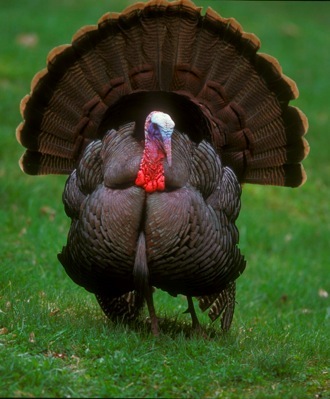Nutrition

The turkey is a very diverse eater! They literally eat almost anything that is slow enough to catch or small enough to swallow! This is possible because turkeys are omnivores like us. Turkeys typically swallow their food and will be ground up in the gizzard later. Turkeys feed the most during the morning and evening and during the middle of the day they rest. Turkeys will eat during the middle of the day however they are seen eating more during the morning and evening.
Quick Fact!
the turkey is the largest bird in north america!
Baby turkeys, or poults, instinctively eat anything that moves after hatching. From then on it learns everything from its mother. Typically poults eat more insects and other foods rich in protein because of their extremely fast growing bodies. By the time the poults are ten weeks old they are eating relatively the same foods as the adult turkeys.
Feeding Habits
Digestion
The turkey has a very unique digestive system containing two extremely important and durable organs called the gizzard. Also, turkeys have been recognized as having one of the longest digestive systems in relation to its body weight. This is because of low nutrient uptake in their diet. This digestive system allows the turkey to obtain nutrients from anything from low nutrient green plant matter to protein rich insects.
When turkeys eat seeds that have a strong shell like an acorn it is usually swallowed whole. In order for the turkey to digest the acorn it has evolved a specialized digestive organ called the gizzard. The gizzard is found in some form in seed eating birds. The gizzard has powerful muscles that grind the food. The turkey will actually eat small pebbles and rocks to aid the organ in the grinding process.
When soft foods like green plant material and some insects are eaten the turkey will digest these contents within one-half a day. However, when the turkey eats seeds and other harder food materials it will take much longer for the turkey to pass it through the digestive system. This is because the hard food has to remain in the gizzard for a longer period of time for the purpose of grinding.
Competition
Like I said before turkeys are very diverse eaters and this allows them to eat almost anything. However, when food does become scarce a couple key characteristics happen within the flock. If food is a priority many times the flocks will split up and become smaller so competition for food is not as great. When food is plentiful you will generally see larger flocks of turkeys.
There is some competition for food with other animal species. For example, the White-tailed Deer (Odocoileus virginianus), many rodents, squirrels, and ruffed grouse are all competing for the same general food.
Quick Fact!
An adult male turkey can eat up to 1 pound of food a day!
want to learn more?

